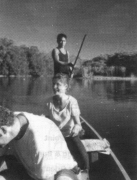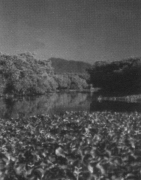
"Would you look at that?" Judith pointed down the beach--the sun was rising at the exact point on the horizon where the waves met the sand. Great salty mists burst forth in a prism of sun-soaked colors. This scene was an added bonus. We had risen before sunrise in order to meet up with Jaime Antonio Hernández. A voice called to us from the opposite direction. It was him and he was right on time.
Jaime, owner of Sapo Tours, is better known as 'Brother.' When we met him the previous day he had said that our trip to the beach wouldn't be complete until we visited the Monterrico Nature Reserve.
 |
Deep within the mangroves we disembarked to feel the rich mud between our toes. A group of shorebirds scattered before us on their spindly legs, leaving behind their frantic cuneiform.
 |
The mangroves are not just a beautiful refuge that supports a wide variety of plant and animal life; they also protect the coastline from erosion and provide a barrier against storms. It is a complex ecosystem, from the birds in the upper branches to the crabs, fish, and shrimp larvae that thrive among the roots. The tannins that stain the waters the color of tea are used to tan hides, and one particular sap is a natural remedy for throat ailments. The reed beds provide shelter to a grand population of animals.
Sapo Tours offer 1-1/2 to 2-hour excursions through the Monterrico Nature Reserve for somewhere in the neighborhood of Q40. For more information stop by the visitor center at the Tortugario Monterrico located on the beach heading east, where the main street meets the sea. It is important to find a guide with a paddle canoe--not a gasoline engine. You can plan your tour for any hour of the day, but I highly recommend going early in the morning. Most of all, don't miss the opportunity to visit the reserve, it is definitely nature's version of Venice.
--Review, Guatemala's English-language Magazine
February 2002
Year 10. no. 11, pp. 74-75.